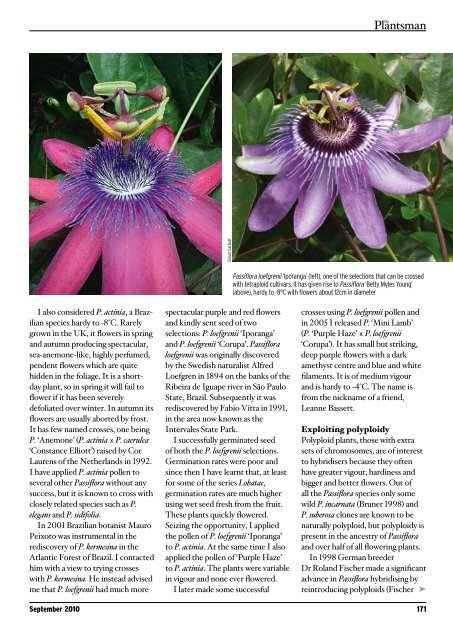Breeding hardy Passiflora - Passion Flowers
Breeding hardy Passiflora - Passion Flowers
Breeding hardy Passiflora - Passion Flowers
You also want an ePaper? Increase the reach of your titles
YUMPU automatically turns print PDFs into web optimized ePapers that Google loves.
The<br />
Plantsman<br />
Simon Garbutt<br />
<strong>Passiflora</strong> loefgrenii ‘Iporanga’ (left), one of the selections that can be crossed<br />
with tetraploid cultivars. It has given rise to <strong>Passiflora</strong> ‘Betty Myles Young’<br />
(above), <strong>hardy</strong> to -8°C with flowers about 12cm in diameter<br />
I also considered P. actinia, a Brazilian<br />
species <strong>hardy</strong> to -8°C. Rarely<br />
grown in the UK, it flowers in spring<br />
and autumn producing spectacular,<br />
sea-anemone-like, highly perfumed,<br />
pendent flowers which are quite<br />
hidden in the foliage. It is a shortday<br />
plant, so in spring it will fail to<br />
flower if it has been severely<br />
defoliated over winter. In autumn its<br />
flowers are usually aborted by frost.<br />
It has few named crosses, one being<br />
P. ‘Anemone’ (P. actinia x P. caerulea<br />
‘Constance Elliott’) raised by Cor<br />
Laurens of the Netherlands in 1992.<br />
I have applied P. actinia pollen to<br />
several other <strong>Passiflora</strong> without any<br />
success, but it is known to cross with<br />
closely related species such as P.<br />
elegans and P. sidifolia.<br />
In 2001 Brazilian botanist Mauro<br />
Peixoto was instrumental in the<br />
rediscovery of P. kermesina in the<br />
Atlantic Forest of Brazil. I contacted<br />
him with a view to trying crosses<br />
with P. kermesina. He instead advised<br />
me that P. loefgrenii had much more<br />
September 2010<br />
spectacular purple and red flowers<br />
and kindly sent seed of two<br />
selections: P. loefgrenii ‘Iporanga’<br />
and P. loefgrenii ‘Corupa’. <strong>Passiflora</strong><br />
loefgrenii was originally discovered<br />
by the Swedish naturalist Alfred<br />
Loefgren in 1894 on the banks of the<br />
Ribeira de Iguape river in São Paulo<br />
State, Brazil. Subsequently it was<br />
rediscovered by Fabio Vitta in 1991,<br />
in the area now known as the<br />
Intervales State Park.<br />
I successfully germinated seed<br />
of both the P. loefgrenii selections.<br />
Germination rates were poor and<br />
since then I have learnt that, at least<br />
for some of the series Lobatae,<br />
germination rates are much higher<br />
using wet seed fresh from the fruit.<br />
These plants quickly flowered.<br />
Seizing the opportunity, I applied<br />
the pollen of P. loefgrenii ‘Iporanga’<br />
to P. actinia. At the same time I also<br />
applied the pollen of ‘Purple Haze’<br />
to P. actinia. The plants were variable<br />
in vigour and none ever flowered.<br />
I later made some successful<br />
crosses using P. loefgrenii pollen and<br />
in 2005 I released P. ‘Mini Lamb’<br />
(P. ‘Purple Haze’ x P. loefgrenii<br />
‘Corupa’). It has small but striking,<br />
deep purple flowers with a dark<br />
amethyst centre and blue and white<br />
filaments. It is of medium vigour<br />
and is <strong>hardy</strong> to -4°C. The name is<br />
from the nickname of a friend,<br />
Leanne Bassett.<br />
Exploiting polyploidy<br />
Polyploid plants, those with extra<br />
sets of chromosomes, are of interest<br />
to hybridisers because they often<br />
have greater vigour, hardiness and<br />
bigger and better flowers. Out of<br />
all the <strong>Passiflora</strong> species only some<br />
wild P. incarnata (Bruner 1998) and<br />
P. suberosa clones are known to be<br />
naturally polyploid, but polyploidy is<br />
present in the ancestry of <strong>Passiflora</strong><br />
and over half of all flowering plants.<br />
In 1998 German breeder<br />
Dr Roland Fischer made a significant<br />
advance in <strong>Passiflora</strong> hybridising by<br />
reintroducing polyploids (Fischer ➤<br />
171
















